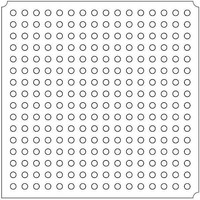LFXP2-8E-5FTN256I Lattice, LFXP2-8E-5FTN256I Datasheet - Page 258

LFXP2-8E-5FTN256I
Manufacturer Part Number
LFXP2-8E-5FTN256I
Description
FPGA - Field Programmable Gate Array 8K LUTs 201 I/O Inst on DSP 1.2V -5 Spd
Manufacturer
Lattice
Datasheet
1.LFXP2-8E-5FTN256I.pdf
(341 pages)
Specifications of LFXP2-8E-5FTN256I
Number Of Macrocells
8000
Number Of Programmable I/os
201
Data Ram Size
226304
Supply Voltage (max)
1.26 V
Maximum Operating Temperature
+ 100 C
Minimum Operating Temperature
- 40 C
Mounting Style
SMD/SMT
Supply Voltage (min)
1.14 V
Package / Case
FTBGA-256
Number Of Logic Elements/cells
*
Number Of Labs/clbs
*
Total Ram Bits
226304
Number Of I /o
201
Number Of Gates
-
Voltage - Supply
1.14 V ~ 1.26 V
Mounting Type
*
Operating Temperature
-40°C ~ 100°C
Package
256FTBGA
Family Name
LatticeXP2
Device Logic Units
8000
Typical Operating Supply Voltage
1.2 V
Maximum Number Of User I/os
201
Ram Bits
226304
Re-programmability Support
Yes
Lead Free Status / RoHS Status
Lead free / RoHS Compliant
Available stocks
Company
Part Number
Manufacturer
Quantity
Price
Company:
Part Number:
LFXP2-8E-5FTN256I
Manufacturer:
Lattice Semiconductor Corporation
Quantity:
10 000
- Current page: 258 of 341
- Download datasheet (10Mb)
Lattice Semiconductor
Ambient and Junction Temperatures and Airflow
A common method of characterizing a packaged device’s thermal performance is with thermal resistance, or . For
a semiconductor device, thermal resistance indicates the steady state temperature rise of the die junction above a
given reference for each watt of power (heat) dissipated at the die surface. Its units are °C/W.
The most common examples are
tance Junction-to-Case (also in °C/W). Another factor is
Knowing the reference (i.e. ambient, case, or board) temperature, the power, and the relevant value, the junction
temp can be calculated by the following equations.
While T
P is the total power dissipation of the device.
a high conductivity case mounted directly to a PCB or heatsink. And
the package is known.
The Power Calculator utilizes the Ambient Temperature (°C) to calculate the Junction Temperature (°C) based on
the
more accurate value of the Junction temperature.
Managing Power Consumption
One of the most critical design factors today is the reduction of system power consumption, especially for modern
handheld devices and electronics. There are several design techniques that can significantly reduce overall system
power consumption. Some of these include:
JA
is commonly used with natural and forced convection air-cooled systems.
1. Reducing operating voltage.
2. Operating within the specified package temperature limitations.
3. Using the optimum clock frequency to reduce power consumption, since dynamic power is directly propor-
4. Reducing the span of the design across
5. Reducing the voltage swing of the I/Os where possible.
6. Using optimum encoding where possible. For example, a 16-bit binary counter has, on average, only 12%
7. Minimize the operating temperature, by the following methods:
JA
J
tional to the frequency of operation. Designers must determine if a portion of their design can be clocked at
a lower rate that will reduce power.
Activity Factor and a 7-bit binary counter has an average of 28% Activity Factor. On the other hand, a 7-bit
Linear Feedback Shift Register could toggle as much as 50% Activity Factor, which causes higher power
consumption. A gray code counter, where only one bit changes at each clock edge, will use the least
amount of power, as the Activity Factor would be less than 10%.
for the targeted device, per Equation 1 above. Users can also provide the Airflow values (in LFM) to get a
, T
A
,T
a. Use packages that can better dissipate heat. For example, packages with lower thermal impedance.
b. Place heat sinks and thermal planes around the device on the PCB.
c. Better airflow techniques using mechanical airflow guides and fans (both system fans and device
C
mounted fans).
and T
B
are the Junction, Ambient, Case (or Package) and Board temperatures (in °C) respectively,
JA
, Thermal Resistance Junction-to-Ambient (in °C/W) and
T
T
T
J
J
J
= T
= T
= T
12-14
A
C
B
+
+
+
JB
, Thermal Resistance Junction-to-Board (in °C/W).
JA
JC
JB
* P
* P
* P
Power Estimation and Management
JB
applies when the board temp adjacent to
JC
is useful when the package has
for LatticeXP2 Devices
JC
, Thermal Resis-
(1)
(2)
(3)
Related parts for LFXP2-8E-5FTN256I
Image
Part Number
Description
Manufacturer
Datasheet
Request
R

Part Number:
Description:
FPGA - Field Programmable Gate Array 8K LUTs 100I/O Inst- on DSP 1.2V -5 Spd
Manufacturer:
Lattice
Datasheet:

Part Number:
Description:
FPGA - Field Programmable Gate Array 8K LUTs 201I/O Inst- on DSP 1.2V -5 Spd
Manufacturer:
Lattice
Datasheet:

Part Number:
Description:
FPGA - Field Programmable Gate Array 8K LUTs 100 I/O Inst on DSP 1.2V -5 Spd
Manufacturer:
Lattice
Datasheet:

Part Number:
Description:
IC, LATTICEXP2 FPGA, 435MHZ, QFP-208
Manufacturer:
LATTICE SEMICONDUCTOR
Datasheet:

Part Number:
Description:
FPGA - Field Programmable Gate Array 8K LUTs 86I/O Inst- on DSP 1.2V -5 Spd
Manufacturer:
Lattice

Part Number:
Description:
FPGA - Field Programmable Gate Array 8K LUTs 201I/O Inst- on DSP 1.2V -7 Spd
Manufacturer:
Lattice
Datasheet:
Part Number:
Description:
FPGA LatticeXP2 Family 8000 Cells Flash Technology 1.2V 144-Pin TQFP
Manufacturer:
LATTICE SEMICONDUCTOR
Datasheet:

Part Number:
Description:
IC DSP 8KLUTS 146I/O 208PQFP
Manufacturer:
Lattice
Datasheet:

Part Number:
Description:
IC DSP 8KLUTS 100I/O 144TQFP
Manufacturer:
Lattice
Datasheet:

Part Number:
Description:
IC DSP 8KLUTS 86I/O 132CSBGA
Manufacturer:
Lattice
Datasheet:

Part Number:
Description:
IC DSP 8KLUTS 86I/O 132CSBGA
Manufacturer:
Lattice
Datasheet:

Part Number:
Description:
IC DSP 8KLUTS 146I/O 208PQFP
Manufacturer:
Lattice
Datasheet:

Part Number:
Description:
IC DSP 8KLUTS 201I/O 256FTBGA
Manufacturer:
Lattice
Datasheet:

Part Number:
Description:
IC FPGA 8KLUTS 86I/O 132-BGA
Manufacturer:
Lattice
Datasheet:

Part Number:
Description:
IC FPGA 8KLUTS 86I/O 132-BGA
Manufacturer:
Lattice
Datasheet:











